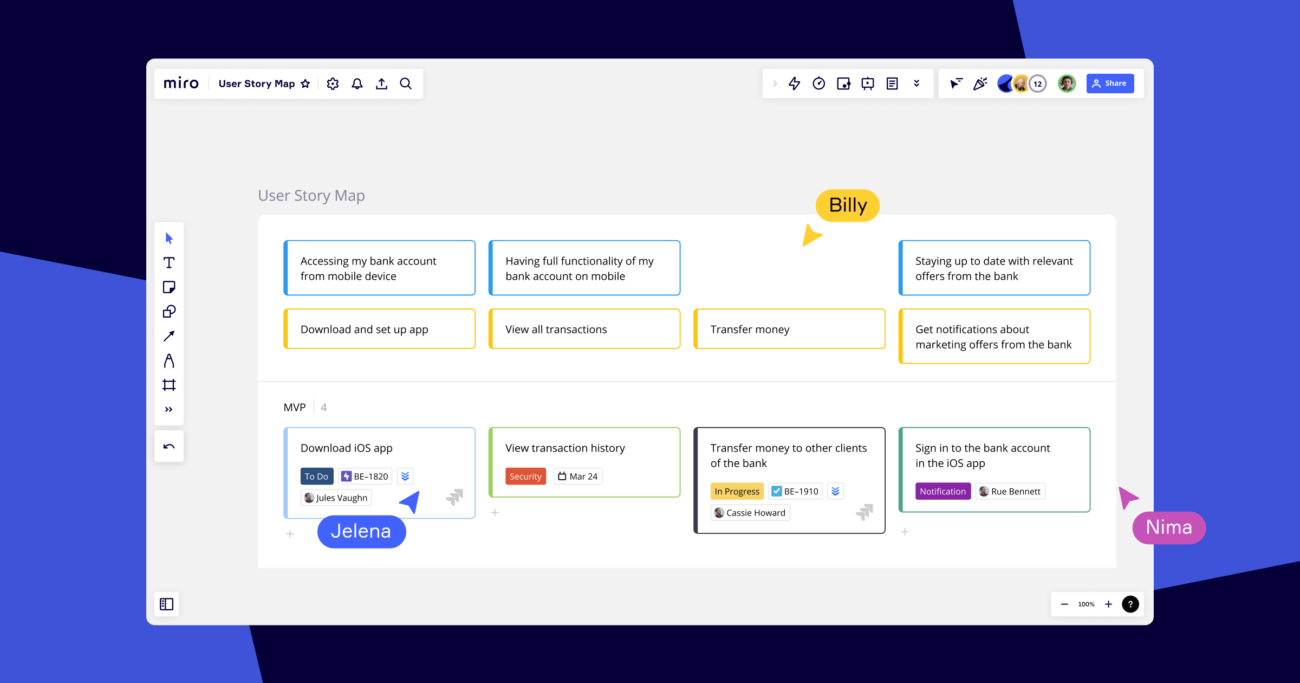Realtime Collaborative Whiteboard Tools (like Miro) for Design Engineers
Design engineers play a crucial role in creating innovative products and solutions, utilizing powerful software like Solidworks for 3D modeling and prototyping. However, the design process often requires effective collaboration, brainstorming, and visual communication with team members, stakeholders, and clients. This is where Miro, a versatile online whiteboarding tool, can greatly enhance the work of design engineers. Miro is a digital collaboration tool similar to LucidSpark and Figjam. In this article, we will explore how engineers can leverage Miro alongside Solidworks to streamline their workflows, foster collaboration, and optimize the prototyping process.
- Concept Development and Brainstorming: Miro’s virtual whiteboard provides an ideal platform for design engineers to brainstorm and ideate with team members, irrespective of their location. They can use Miro to create mind maps, flowcharts, and concept diagrams to explore different design possibilities. By importing sketches, screenshots, or even Solidworks models directly into Miro, engineers can visually represent their ideas, encourage feedback, and collectively refine concepts before diving into the detailed design phase.
- Design Review and Feedback: Design engineers often need to present their work to stakeholders and clients for feedback and approval. Miro offers a convenient way to showcase Solidworks models, renderings, or product animations in an interactive and collaborative environment. Engineers can use Miro’s commenting feature to gather feedback directly on specific design elements, annotate the model, or hold discussions on proposed modifications. This enables real-time collaboration and ensures that all stakeholders are aligned before proceeding further.
- Collaborative Design Workshops: Miro’s online collaboration features are well-suited for design workshops and design thinking sessions. Design engineers can organize virtual workshops where participants can collectively contribute to the design process, irrespective of their physical location. By integrating Miro with tools like Solidworks, engineers can import existing designs, share screens, and collaborate on virtual whiteboards, allowing for seamless real-time collaboration, idea generation, and decision-making.
- Iterative Prototyping and Design Documentation: When it comes to iterating on designs and documenting changes, Miro can be an invaluable tool for design engineers. By importing Solidworks models into Miro, engineers can annotate design revisions, highlight specific areas, or add explanatory notes. This visual documentation not only helps engineers communicate changes effectively but also aids in keeping track of design iterations and the decision-making process, ensuring a comprehensive design history.
- Cross-Functional Collaboration: Design engineers often work closely with teams from different disciplines, such as manufacturing, marketing, and sales. Miro’s versatile collaboration features enable seamless cross-functional collaboration. Engineers can use Miro to create workflows, process diagrams, and design guidelines, ensuring clarity and alignment across teams. Integrating Solidworks designs into Miro allows for easy sharing of technical specifications, design requirements, and manufacturing guidelines, enabling efficient collaboration among team members.

Need more ideas? Here is a list of 20 ways engineers can use whiteboard tools like Miro to enhance their work:
- Brainstorming and ideation sessions for concept development.
- Visualizing and organizing design requirements, specifications, and constraints.
- Collaborative design thinking workshops to generate innovative ideas.
- Creating mind maps and flowcharts to map out complex design processes.
- Importing Solidworks models and designs to receive real-time feedback.
- Collaborative annotation and markup of Solidworks models for design review.
- Sharing and presenting design proposals to stakeholders and clients.
- Conducting virtual design reviews with remote team members.
- Creating design documentation and version control for iterative improvements.
- Collaborating with cross-functional teams, such as manufacturing and marketing.
- Mapping out user journeys and interaction flows for user-centric design.
- Creating wireframes and mockups for user interface design.
- Collaborative problem-solving and troubleshooting sessions.
- Virtual project management, tracking progress, and assigning tasks.
- Importing images, diagrams, and technical drawings for reference and context.
- Conducting competitive analysis and benchmarking of existing designs.
- Collaborative risk assessment and mitigation planning.
- Creating interactive presentations and demonstrations of design concepts.
- Organizing and prioritizing design requirements in product development.
- Documenting design decisions, rationale, and design history.
These 20 use cases highlight the versatility and potential of whiteboard tools like Miro in the engineering field. By leveraging the collaborative features of these tools alongside Solidworks, engineers can streamline their workflows, enhance communication, and foster innovation throughout the design process. You can learn more about what Miro is to get even more ideas and use cases…including AI with Miro.
Miro for Design Engineers Conclusion
Incorporating Miro into the workflows of design engineers who use software like Solidworks can significantly enhance collaboration, streamline design processes, and improve overall productivity. From concept development and design reviews to iterative rough prototyping and cross-functional collaboration, Miro provides a flexible and intuitive platform for design engineers to visually communicate, gather feedback, and document design decisions. By integrating Miro with Solidworks, engineers can unleash the full potential of their design expertise while fostering collaboration and innovation within their teams and organizations. Miro also offers retrospective templates that can help with your team agile workflows.
